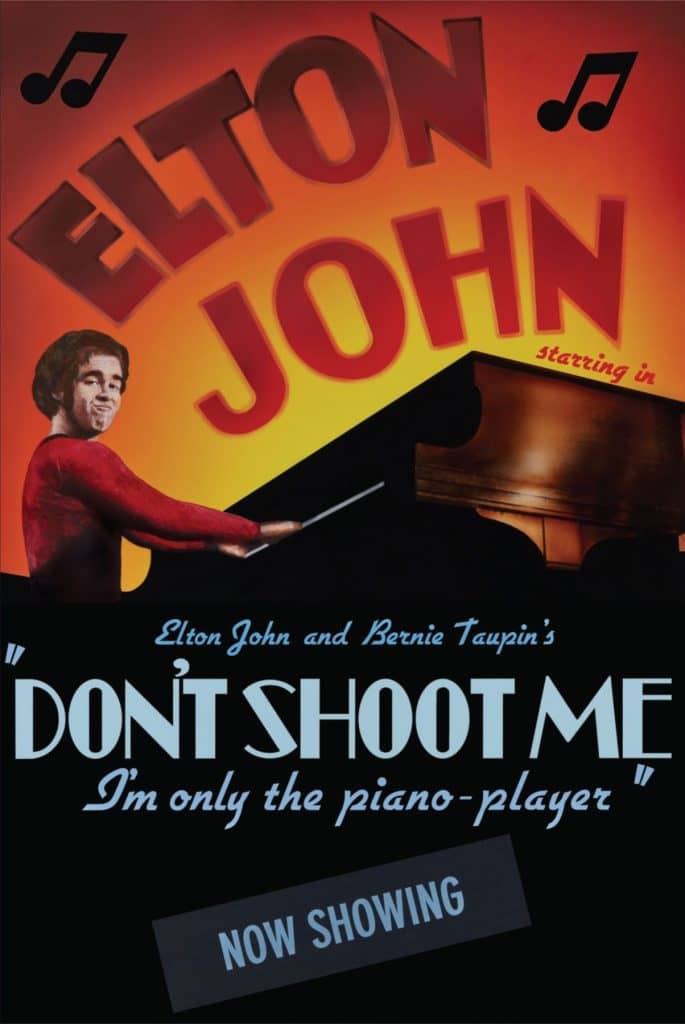Menu
‘Don’t Shoot Me I’m Only The Piano Player’ – Inside the Studio and On the Charts
“If ‘Honky Château’ established Elton John as a leading contender for the bantam-weight championship of rock & roll, ‘Don't Shoot Me I'm Only The Piano Player’ should hand him the title.”
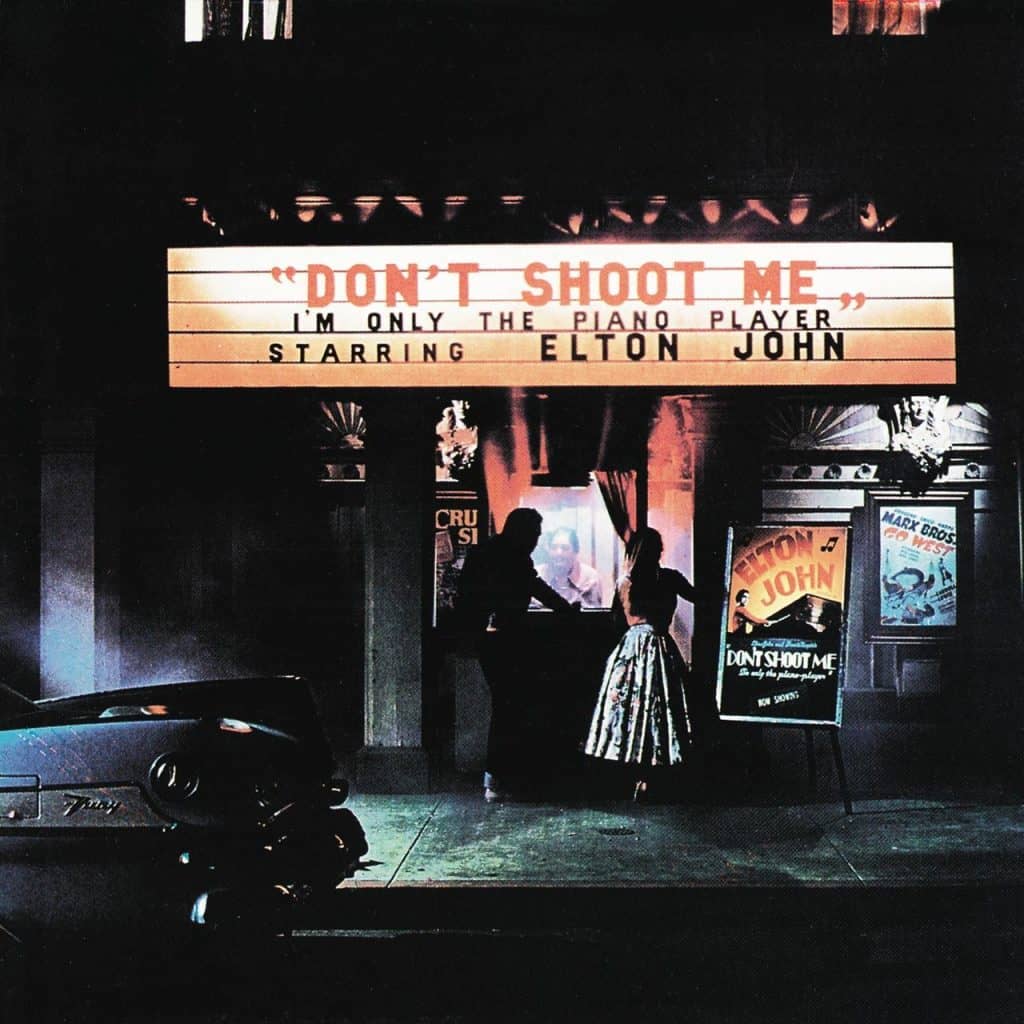
By John F. Higgins
A mere five months after recording his first US No. 1 album, Honky Château, at the Château d Hérouville, Elton John and his band returned to the French countryside to record what would become his first chart-topping LP in the UK, and his second straight in America.
Don’t Shoot Me I’m Only The Piano Player was written, rehearsed, and recorded at the live-in studio between June 5 and 19, 1972, starting just two days after Elton made an impromptu appearance at the Beach Boys show at the Crystal Palace Bowl in London. All of the songs were written during the first few days, with I’m Going To Be A Teenage Idol leading the way, and rehearsed by Elton and the band before producer Gus Dudgeon and engineer Ken Scott turned on the control room’s red “recording” light on June 10.
“We’ve got album-making down to a fine art now,” Elton told Danny Holloway of the New Musical Express in early 1973. “So, when we’ve got one coming out we’ll just be finishing the next one. After Madman, we caught up with ourselves. We stopped working and concentrated on recording.”
“Fine art” (Elton can be forgiven for using that turn of phrase…the Château had been painted by Vincent Van Gogh a century before) indeed – four of the tracks were recorded in one take, with some others deftly laid down in two or three.
In addition to the tracks below, a song called Tell Me What The Doctor Said was written during the sessions, but never recorded. Bernie also submitted a lyric called Calamity Jane, but Elton did not put it to music.
IN THE STUDIO: DAY-BY-DAY
June 10, 1972
★ DANIEL
Original LP: Side 1, Track 1
Musicians
Elton: electric piano, ‘Flute’ Mellotron, and vocals / Nigel Olsson: drums, maracas / Dee Murray: bass / Davey Johnstone: acoustic guitar, banjo / Ken Scott: ARP synthesizer.
Listener’s Notes
- The technique of repeating the solo line (in this case, Davey’s over-dubbed banjo) quietly underneath the following verse would be repeated on Sorry Seems To Be The Hardest Word.
- Daniel was nominated for a 1974 Grammy Award (Best Pop Vocal Performance – Male) and won Elton his first, of 13 to date, Ivor Novello award, for Best Song Musically and Lyrically.
For long-time fans, Daniel holds a special place in the body of Elton John/Bernie Taupin compositions, thanks to Elton making public in interviews and on stage that he excised some of the lyrics while he was writing the music. “So many people have said they can’t understand what Daniel means,” Elton told journalist Paul Gambaccini in 1973. It’s because I left the last verse out.” Bernie explained in 1991 that “The story was about a guy that went back to a small town in Texas, returning from the Vietnam War. They’d lauded him when he came home and treated him like a hero. But, he just wanted to go home, go back to the farm, and try to get back to the life that he’d led before.”
Bernie was inspired to write the story upon reading an article in the March 21, 1971 issue of Newsweek magazine called “Vietnam Vet: ‘No One Gives A Damn’”. Elton determined the lyrics to be a bit too long for his tastes and removed the end as he began to compose at the piano. The missing lyrics have never been revealed…until now.
Discovered deep in Elton’s archives many years later, the full typewritten lyric contains not only an extra verse, but an extra coda as well. After the last line of the chorus (“Daniel you’re a star in the face of the sky”), Bernie writes:
Don’t forget Daniel when the plane touches land
There’s someone in England who still gives a damn
And I did my best to help you forget
War sure is hell when heroes can’t rest
You’re a book I have read dear Daniel
You’re a test I have yet to take Daniel
And try if you can to sleep tonight
If Spain really helps you then you’ll be alright
★ BLUES FOR BABY AND ME
Original LP: Side 1, Track 4
Musicians
Elton: piano and vocals / Nigel: drums / Dee: bass / Davey: acoustic guitar, electric guitar, sitar / Paul Buckmaster: orchestral arrangement.
Listener’s Notes
- Elton considers this a “stock Elton John number,” telling Beat Instrumental writer Steve Turner in January 1973, “it could have been on any of my albums.”
- Bernie continues his American brand product placement, after 1971’s Holiday Inn, with the line “There’s a Greyhound outside in the lane, it’s waitin’ for us.”
- The orchestration on this song, and others on the album, was written after the album was finished and was recorded at Trident Studios in London shortly before the album was mixed there.
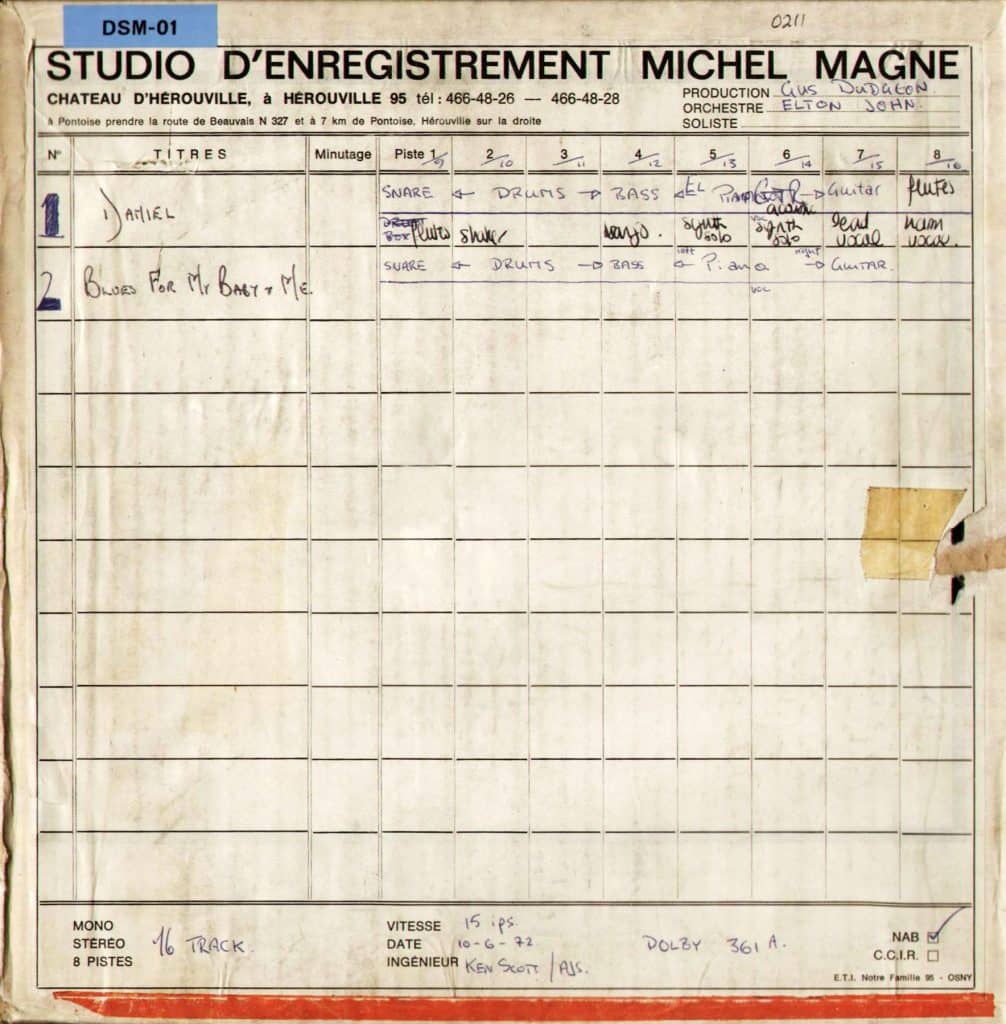
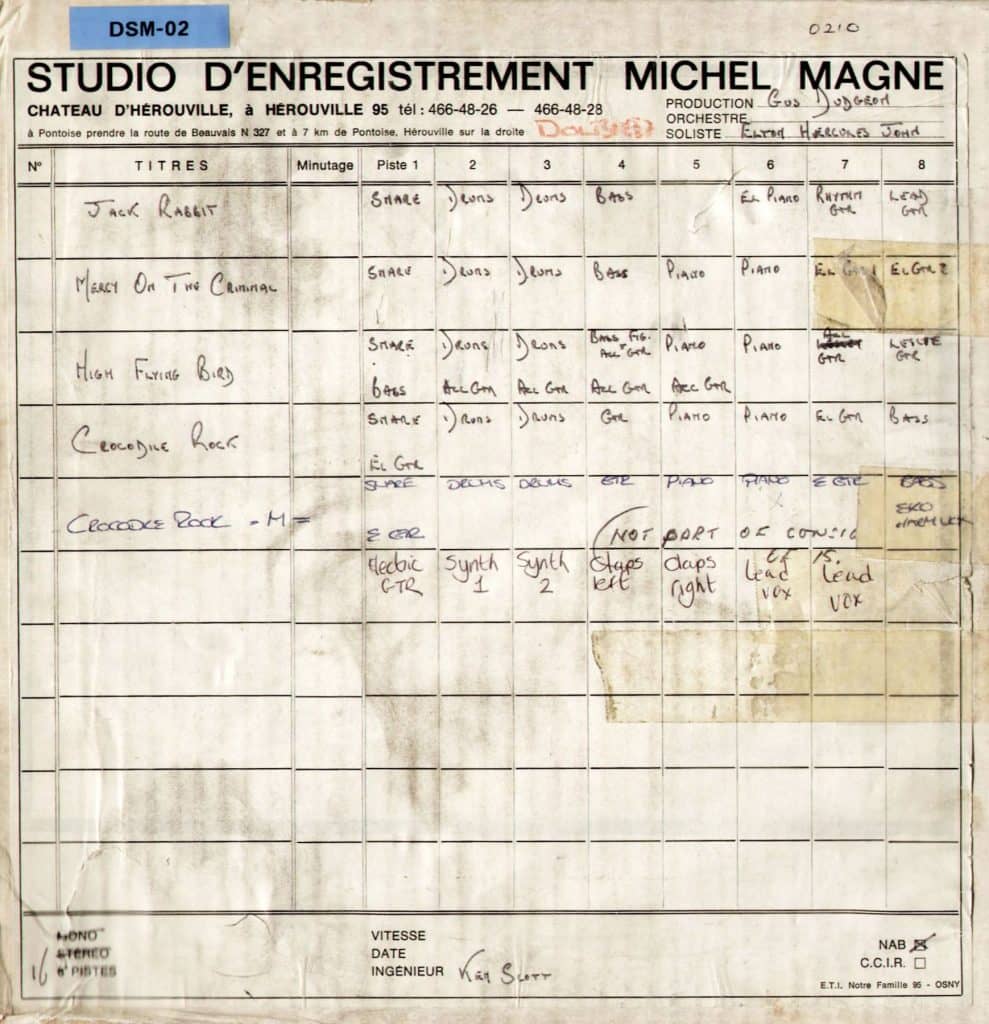
June 11, 1972
★ MIDNIGHT CREEPER
Original LP: Side 1, Track 5
Musicians
Elton: electric piano and vocals / Nigel: drums / Dee: bass / Davey: electric guitars / Jacques Bolognesi: Trombone / Jean-Louis Chautemps: Saxophone / Alain Hatot: Saxophone / Ivan Jullien: Trumpet / Brass arranged by Gus Dudgeon.
Listener’s Notes
- Bernie pop-culture shout-out: Tina Turner.
- Beat Instrumental noted that the song sounds similar in feeling to the 1966 Robert Parker hit, Barefootin’. Gus Dudgeon’s horn arrangement very much contributes to this.
- Gus (1993): “I think in all the time I’ve worked with [Elton], he only asked me to take one instrument off one song, which was a banjo that used to be on Midnight Creeper, like a sort of McGuinness/Flint-type banjo. For some reason he didn’t like it.”
June 12, 1972
★ JACK RABBIT
Original LP: Out-take
Musicians
Elton: electric piano and vocals / Nigel: drums / Dee: bass / Davey: rhythm and lead guitars.
Listener’s Notes
- Newly discovered for the 50th Anniversary Edition, this song was re-recorded during the Goodbye Yellow Brick Road sessions the following year.
★ HAVE MERCY ON THE CRIMINAL
Original LP: Side 2, Track 1
Musicians
Elton: piano and vocals / Nigel: drums / Dee: bass / Davey: electric guitars / Paul B: orchestral arrangement.
Listener’s Notes
- In introducing this song during concerts in the 80s, and beyond, Elton would go out of his way to mention Paul Buckmaster’s arrangement on this track, calling it one of his personal favorites.
- Elton plays this as the sixth song during his Farewell Yellow Brick Road tour shows.
★ TEXAN LOVE SONG
Original LP: Side 2, Track 3
Musicians
Elton: harmonium and vocals / Nigel: drums / Dee: bass / Davey: acoustic guitar, mandolin, foot-tapping (uncredited).
Listener’s Notes
- Cited by some critics as similar to some of the Fairport Convention’s folk-rock music of the late 1960s, and by others as not unlike the Beatles’ Blackbird, noting the foot-tapping sound in both songs.
- The tenth song in Elton’s catalog on which he does not play piano or electric piano.
- The harmonium Elton plays on this track can be seen in the 1973 Goodbye Yellow Brick Road television documentary Elton John & Bernie Taupin Say Goodbye To Norma Jean and Other Things, and is the same as was used on the song Latitude from 1995’s Made In England.
A versatile rock-and-roll package that proudly displays the effortless craftsmanship of mature, experienced rock songwriters and rock musicians. John, whether he us experimenting with the newly discovered rhythms of the Caribbean or writing a country tune to rival any in Merle Haggard’s catalog, continues to exhibit his gift for uncommon melody.
June 13, 1972
★ HIGH FLYING BIRD
Original LP: Side 2, Track 5
Musicians
Elton: piano and vocals / Nigel: drums, backing vocals / Dee: bass, backing vocals / Davey: Leslie guitar, acoustic guitars, backing vocals.
Listener’s Notes
- Elton called it “A cross between Crosby, Stills and Nash and Irma Franklin” in a 1973 interview.
- Researcher Mark Lewisohn notes that a John/Taupin song called High Flyin’ Bird was submitted for UK copyright registration in June 1970.
★ CROCODILE ROCK
Original LP: Side 2, Track 4
Musicians
Elton: piano, Farfisa organ, vocals / Nigel: drums / Dee: bass / Davey: electric guitars.
Listener’s Notes
- Elton told Paul Gambaccini in 1973, “I always wanted to write a nostalgic song a rock and roll song which captured the right sounds.” He cited songs and artists like Little Darlin’, Oh Carol, the Beach Boys, and Eddie Cochran. The lyrics themselves hint at Bill Haley and His Comets’ See Ya Later, Alligator and also reference their 1954 hit Rock Around The Clock.
- Elton was sued by the people who wrote Pat Boone’s 1966 hit Speedy Gonzalez for the falsetto “la-la-la-lahhh” parts in the chorus. The parties settled out of court.
- Elton famously performed this song on the Muppet Show in 1977 with “Dr. Teeth and the Electric Mayhem”…and crocodiles. In the mid-1990s, he reinterpreted the song as a ballad in concert.
★ I’M GOING TO BE A TEENAGE IDOL
Original LP: Side 2, Track 2
Musicians
Elton: piano, Leslie piano, vocals / Nigel: drums, backing vocals / Dee: bass, backing vocals / Davey: electric guitars, acoustic guitars, backing vocals / Jacques B: Trombone / Jean-Louis C: Saxophone / Alain H: Saxophone / Ivan J: Trumpet / Brass arranged by Gus D.
Listener’s Notes
- Dedicated to Elton’s close friend Marc Bolan, leader of the band T. Rex. Bernie was quoted by Paul Gambaccini as saying, “As far as I am concerned, it wasn’t written exactly about Marc. He was the sort of the image I was talking about, and it just so happens he was the closest person to associate with that song.”
- Elton told Beat Instrumental in January 1973, “We played it to him and I think he liked it. He didn’t hit me anyway.”
- Gus (1993): “We all had a soft spot for Marc. He was a really sweet little guy. Elton may well have asked him at some stage if he wanted to [record something together], but it was never suggested on a session.”
June 14, 1972
★ SKYLINE PIGEON
Original LP: b-side to Daniel single
Musicians
Elton: piano and vocals / Nigel: drums / Dee: bass / Davey: acoustic guitar / Paul B: orchestral arrangement.
Listener’s Notes
- This is a re-recording of the 1969 song from Elton’s debut album Empty Sky, using a piano and Elton’s band, and a stunning arrangement by Paul Buckmaster, instead of just a harpsichord.
- Gus (1993): “Skyline Pigeon was re-recorded because my wife [Sheila] persuaded Elton to do it. She just loves that song. It’s a fabulous song. It really is. I’ve always liked the song myself and she just talked him into it.”
June 15, 1972
★ TEACHER I NEED YOU
Original LP: Side 1, Track 2
Musicians
Elton: piano, Mellotron, vocals / Nigel: drums, backing vocals / Dee: bass, backing vocals / Davey: acoustic guitar, backing vocals.
Listener’s Notes
- Bernie pop-culture shout-outs: John Wayne and Errol Flynn.
- Elton (1973): “This one’s a cross between Bobby Vee and the Moody Blues. The Moody Vees perhaps?”
- In 1993, Gus explained the effects he put on Elton’s part: “It’s actually backwards-echo on the piano. What you do is, after you’ve recorded the track, you turn the tape over backwards … and you record echo from the piano onto a separate track. When you put the tape back the right way, the echo of the piano occurs before the piano.”
★ ELDERBERRY WINE
Original LP: Side 1, Track 3
Musicians
Elton: piano and vocals / Nigel: drums / Dee: bass / Davey: electric guitars / Jacques B: Trombone / Jean-Louis C: Saxophone / Alain H: Saxophone / Ivan J: Trumpet / Brass arranged by Gus D.
Listener’s Notes
- Elton opened his 1973 concerts with this song but has not performed it since 1974.
★ HI-HEEL SNEAKERS
Original LP: Out-take
Musicians
Elton: piano and vocals / Nigel: drums / Dee: bass / Davey: electric guitars.
Listener’s Notes
- A previously unreleased cover of the 1964 blues song written (as Robert Higgenbotham) and recorded by Tommy Tucker.
- Elton injects a vocal tribute to Lee Dorsey’s recent hit, singing “Yes we are-are” instead of Yes We Can Can.
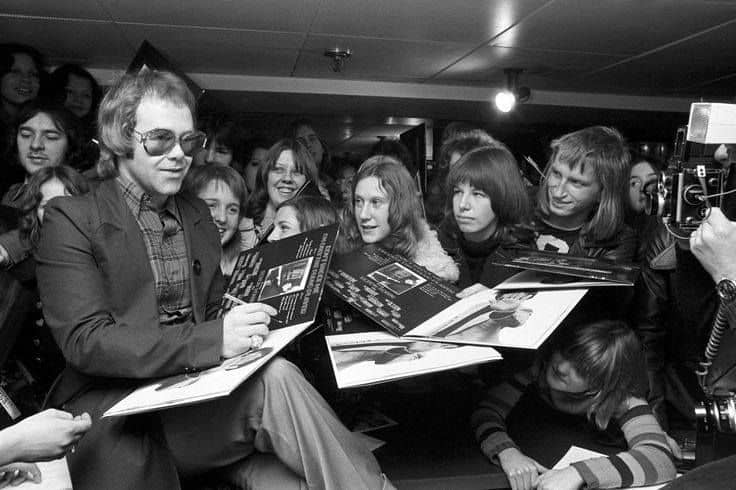
On January 20, 1973, Elton spent the afternoon signing copies of Don’t Shoot Me I’m Only The Piano Player at Noel Edmonds record shop on the King’s Road, Chelsea.
RELEASE/CHART INFO
UK LP
Released: January 26, 1973, on DJM.
- Entered UK Albums Chart: No. 1 on Feb. 10, for six weeks
- Weeks on chart: 42 non-consecutive
US LP
Released: January 22, 1973, on MCA.
- Entered Billboard Top 200: No. 98 on Feb. 10
- Weeks on Top 200: 89
- Top 200 Peak: No. 1 on March 10, 1973, for two weeks
- Current RIAA Status: 3x Platinum.
UK SINGLES
Crocodile Rock b/w Elderberry Wine
Released: October 27, 1972, on DJM.
- Entered UK Singles Chart: No. 42 on Nov. 4
- Weeks on chart: 14
- Peak: No. 5 on Nov. 25, for three weeks
- Current BPI Status: Gold
Daniel b/w Skyline Pigeon
Released: January 10, 1973, on DJM.
- Entered UK Singles Chart: No. 38 on Jan. 20
- Weeks on chart: 10
- Peak: No. 4 on Feb. 17
- Current BPI Status: Silver
US SINGLES
Crocodile Rock b/w Elderberry Wine
Released: November 20, 1972, on MCA.
- Entered Billboard Hot 100: No. 73 on Dec. 9
- Weeks on Hot 100: 17
- Hot 100 Peak: No. 1 on Feb. 3, 1973, for three weeks
- Entered Billboard Adult Contemporary (AC): Dec. 9
- Weeks on AC: 8
- AC Peak: No. 11 on Feb. 3, 1973
- Current RIAA Status: Platinum
Daniel b/w Skyline Pigeon
Released: March 26, 1973, on MCA.
- Entered Billboard Hot 100: No. 77 on April 7
- Weeks on Hot 100: 15
- Hot 100 Peak: No. 2 on June 3, 1973
- Entered Billboard AC: April 21
- Weeks on AC: 13
- AC Peak: No. 1 on May 12
- Current RIAA Status: Platinum
There is little doubt that “Don’t Shoot Me I’m Only The Piano Player” (DJM) is the best album to date from Elton John in conjunction with his lyricist Bernie Taupin.
The album cover’s two Art Directors speak about the distinctive photograph on the gatefold.
David Larkham: “For the cover shoot, Michael Ross and I had a lot of help from George Osaki (art director of MCA) and Russ Regan (MCA executive) in getting Universal Studios to do the cinema set-up that we wanted on the back lot. I assumed they’d take it all down the next day. Apparently, the marquee could be there for days or even weeks before a change was necessary; it cost time and money to take it down.”
[Fun fact: The marquee can be seen on an episode of Banacek, a detective TV series that aired on NBC in the early 1970s. About seven minutes into Season 1, Episode 7: “The Greatest Collection of Them All”.]
Michael Ross: “It was an unforgettable experience. As a lifelong movie fan, it was a huge thrill for me to be on the Universal backlot. I’m pretty sure it was a Sunday for one very particular reason – there was a problem about the integral lighting of the theatre, and although the windows at the top are lit, there was an issue with the relevant union about switching on the lights at either side and above the marquee. If you look closely you can see where they would have been. I think this was actually a great stroke of luck – imagine how different the cover would have been if the whole theatre had been lit. It would have been glitzy, instead of somber and atmospheric in an almost ghostly way, which for me is what gives it its appeal.
“The front cover shot had been composed in-camera by photographer Ed Caraeff, through the viewfinder to fit the square format. Ed was a well-established photographer with a track record of high profile and big scale photo shoots. He was impressively in control.
“I designed the back cover layout back in London along with the inside cover credits page and the whole booklet.”
David Larkham: “The top half of the poster outside the theatre was airbrushed lettering and a painting of Elton (based on an Ed Caraeff photo) and piano. The actual side of the piano was a black and white photo, airbrushed over with brown ink, and montaged in place. The bottom half was a photographic print of white type on a black background – and then the type was airbrushed in various blues. The ‘Now Showing’ was a card placard.”
